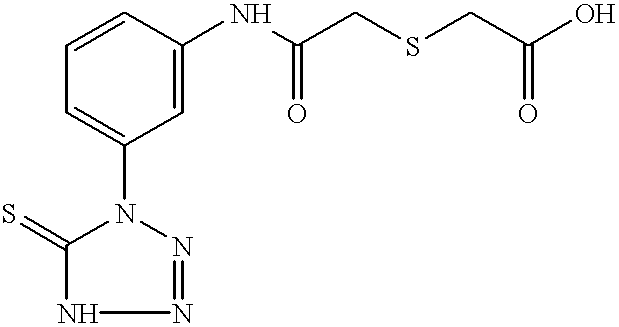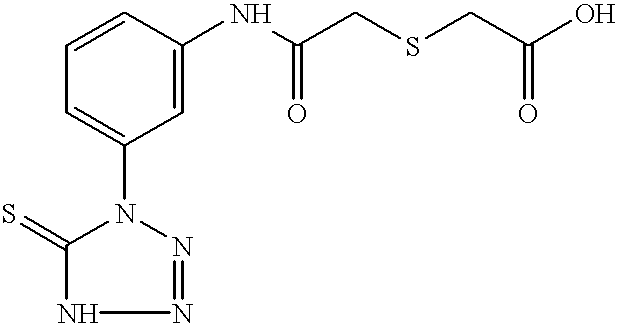Ruthenium ion complexes providing shallow
electron traps desired in order to reach the objects of the present invention, also called dopants, are e.g. those described in an interesting survey of Research Disclosure, Item 36736 (November 1994). Recommended SET's, besides the
ruthenium (
hexa)
cyanate complex compound(s) are e.g.
metal-
halogen-
fluorine complexes, more preferably hexafluoro coordinated
iridium ion complexes described in EP-A 0 945 755, which are also advantageously added to the
emulsion of the present invention. The complex compound dopants disoclosed therein are commonly added in significantly lower amounts to the tabular grains rich in
silver bromide coated in
emulsion form in one or more hydrophilic
layers of the material according to the present invention than as e.g. spectral sensitisers and are thereby causing much less chemical load of the image-forming
system of the present invention. Said dopants can in principle be added in whatever a stage of the emulsion preparation, provided that those dopants are not present in a shell outside the core rich in
silver bromide and extending up to less than 50% (and in a preferred embodiment outside the core extending up to 40%) of all silver precipitated. This is clearly opposite to the localized phase of the cyanocomplexes of metals comprising metals of group VIII in the surface of the grains as disclosed in EP-A 0 613 044 or just beneath the
surface layer having a thickness in the range of from 20 to 350 A as disclosed in EP-A 0 503 736 or in EP-A 0 743 553, situated in an interior grain portion separated from an
iridium containing grain portion by at least 10% of the silver forming the
grain structure. Generally dopants have little influence on
crystal distributions in the emulsions but they may be added to cause advantageous effects with respect to reciprocity, pressure
sensitization, etc.
According to the present invention complex
ion compounds of
ruthenium are incorporated in a limited part of the core portion, preferably the ruthenium
cyanate salts thereof, and more preferably the ruthenium hexacyanate salt is particularly recommended as
dopant(s) for the said core-shell tabular grain emulsions rich in silver
bromide: in the presence of a sole complex ion compound as the preferred [Ru(CN).sub.6 ].sup.4-, in the core of the core-shell tabular grain, wherein said core is more rich in silver
bromide than the shell, it is possible to reach the objects of the present invention, more particularly to reach the desired enhanced contrast without loss in speed.
The non-uniform distributrion of said sole complex ion compounds providing shallow
electron traps plays a dominant role and when the tabular grains rich in silver
bromide are described as core-shell tabular grains this means that the core thereof contains shallow electron trap dopants as
ruthenium compounds mentioned hereinbefore, whereas the shell is completely free thereof. This further means that in the emulsion crystals according to the present invention the dopants providing shallow electron traps can be added from the start of the
nucleation step until addition less than 50% of the total amount of silver (thus during part of the growth step) and before addition of at least the other 50% of silver salt in order to build up the shell of the core-shell tabular grain, wherein said shell has a lower content of silver bromide, in that part of the silver bromide has been replaced by
silver iodide and, optionally by
silver chloride, so that the tabular grains have a silver bromoiodide or bromochloroiodide composition. It may be advantageous to add hole
trapping dopants chosen from carboxylic (formic) acid (salts) and .alpha.-hydroxy sulfenic acid (salts) described in EP-Application No. 98204079, filed Nov. 30, 1998 in order to get further improved sensitometric properties. As
silver iodide present in the core-shell tabular grains of the present invention is divided non-homogeneously over the crystal volume it is preferred that all
silver iodide is concentrated in the outer shell of the core-shell tabular grain, wherein said outer shell represents at least 50% of all silver precipitated and wherein said
iodide is present in an enhanced amount in order to get an average silver
iodide content over the whole grain volume of less than 3 mole %.
In a further preferred embodiment according to the present invention said grains have silver bromide in an average amount of at least 95% and even up to 99 mole % of silver bromide, although even higher amounts of bromide are not excluded. Further according to the present invention said grains have silver
iodide in an average amount over the grain volume of at most 3 mole %, more preferably at most 1 mole %. Although preferred with respect to intrinsic and to
spectral sensitivity it is recommended to limit average iodide concentrations to low levels as disclosed hereinbefore as higher concentrations retard development and lead to unsatisfactory sensitivities. Moreover the velocity of fixation can be disturbed in that case and as a consequence residual colouration may be unavoidable.
More details about grain modifying conditions (
nucleation step, growth steps, physical
ripening steps, also called
Ostwald ripening steps inbetween or at the end) and adjustments during silver halide
precipitation of tabular grain emulsions and specifically with respect to the introduction of dopants can be found in Section I-D of Research Disclosure 38957, published September 1996.
It is clear that special attention should be paid to the way in which the ruthenium complex compound
dopant providing shallow electron traps are introduced during
crystal growth as the stability of the dopants in complex compounds may be limited, depending on the solutions wherein the said compounds are available. Therefore said solution can be introduced by means of a so-called "third-jet" in order to introduce the
dopant in the reaction vessel where rapid incorporation in the growing crystals is performed. In a preferred embodiment e.g. said third-jet is adding the dopant solution in the vicinity of the stirrer, where also new rapidly dissolving
fine grain nuclei are formed which are precipitated further onto growing tabular crystals rich in silver bromide.
 Login to View More
Login to View More  Login to View More
Login to View More 

